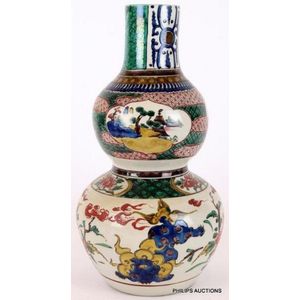Kutani Double Gourd Vase with Landscape and Floral Decor
A Kakiemon style double gourd Kutani vase, Fuku mark common on Kutani, second half 20th century the double gourd vase with a cylindrical neck, decorated with landscape and floral spray cartouches against various polychrome diaper patterned grounds, two large floral sprays to the bottom amidst clouds and foliage, with a green square fuku ('good fortune') mark in running script to the underside, height 38.5 cm
You must be a subscriber, and be logged in to view price and dealer details.
Subscribe Now to view actual auction price for this item
When you subscribe, you have the option of setting the currency in which to display prices to $Au, $US, $NZ or Stg.
This item has been sold, and the description, image and price are for reference purposes only.
- Diaper Motif - The diaper motif is a repeating geometric pattern in decorative arts that consists of small diamond or lozenge shapes arranged in a grid. The pattern is often used as a background or border on textiles, ceramics, metalwork, and other decorative items. It can be found in a variety of cultures and historical periods, and is often used in formal or ornamental designs. The name "diaper" comes from the pattern's resemblance to the criss-crossed fabric of a baby's diaper.
- Polychrome - Made or finished in many colours. For furniture, it is used to indicated a painted finish.
- Kakiemon Porcelain - Kakiemon porcelain was made from the 16th to the 19th century in the Arita area of Japan, and is generally agreed to include some of the finest porcelain made in Japan. It is decorated with polychrome enamels over glaze, the most popular colours being underglaze blue and enamels of green, blue, turquoise yellow and persimmon red.
The body of a Kakiemon object is pure white porcelain while the enamel overglaze motifs incorporate Japanese and Chinese designs, but leave much of the white surface unpainted. The name derives from the family of potters who are associated with this style of pottery.
Early Kakiemon porcelain was unmarked, and marks on later objects were variable and unreliable.
Kakiemon porcelain was first imported into Europe by the Dutch at the end of the 17th century, and became extremely popular, resulting in Kakiemon-style imitations being produced by European potteries including Bow, Chelsea and Worcester in England, Mennery, Samson and St. Cloud in France, Delft in Holland and Meissen in Germany.
It's rare for an original Kakiemon object to come onto the market, and almost all sold nowadays is of European origin, and described as Kakiemon pattern or Kakiemon style.
This item has been included into following indexes:
